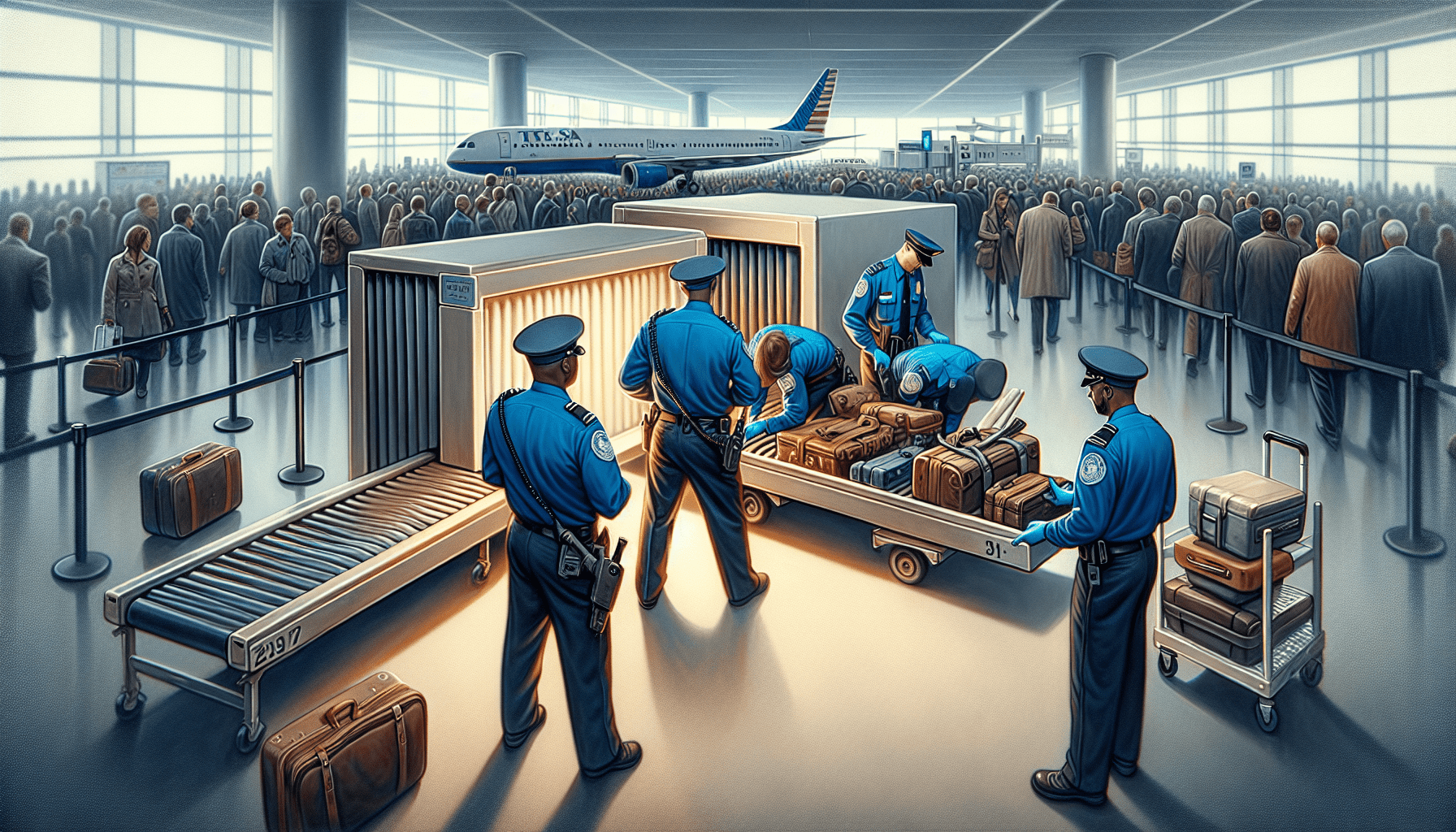When it comes to air travel, everyone wants to feel safe and secure. That’s why the Transportation Security Administration (TSA) was formed in 2001, to prevent another devastating attack like 9/11. TSA agents are dedicated to ensuring everyone follows the rules and regulations, with the goal of keeping all passengers safe. To make your journey through airport security a smooth one, it’s important to follow a few simple guidelines. First and foremost, always listen to and follow the instructions given by TSA agents, and maintain a calm and compliant demeanor. Being polite and minding your manners can go a long way in avoiding any unnecessary flags or delays. Plan ahead and give yourself plenty of time to get through security and to your gate, as rushing can cause suspicion. Remember the 3-1-1 rule for liquids, aerosols, and gels, and make sure to pack them correctly to avoid any issues. Additionally, it’s important to have the proper identification and boarding pass that match your name, as mismatches can raise concerns. Lastly, avoid making any jokes or statements about bombs, drugs, or violence at the airport, as it can cause unnecessary alarm. Dressing in a way that is easy for security to inspect, by avoiding excessive layers or accessories, can also expedite the process. By following these simple guidelines, you can help ensure a safe and efficient screening process while traveling.

Shop These Accessories for a Comfortable Trip
The Formation of TSA in 2001
The Transportation Security Administration (TSA) was established in 2001 as a response to the devastating terrorist attacks on September 11th, 2001. Its primary purpose is to prevent similar attacks from happening again by enhancing security measures within the transportation system. The formation of TSA marked a turning point in airport security, as it centralized and professionalized the screening process, aiming to ensure the safety and well-being of travelers across the United States.
TSA’s Establishment and Purpose
The establishment of the TSA was a direct result of the 9/11 attacks, which exposed vulnerabilities in the nation’s airport security measures. In response, the U.S. Congress passed the Aviation and Transportation Security Act, which led to the creation of the TSA. The primary purpose of the TSA is to protect the nation’s transportation systems, including airports, by implementing and enforcing security measures to prevent future acts of terrorism.
TSA’s Role in Preventing Future Attacks
The TSA plays a critical role in preventing future attacks by implementing stringent security measures and employing thousands of dedicated agents. TSA agents are responsible for the screening of passengers, baggage, and cargo, utilizing advanced technology to detect and mitigate potential threats. Through thorough inspections, the TSA aims to identify and resolve security vulnerabilities, ensuring the safety of all passengers and maintaining the integrity of the transportation system.
TSA Agents and Their Responsibilities
TSA agents have the crucial responsibility of ensuring compliance with rules and regulations in order to maintain the security and safety of the traveling public. They are trained to identify prohibited items and potential threats, employing both technology and behavioral observation techniques. If a potential threat or suspicious individual is identified, TSA agents have procedures in place to handle the situation, ensuring the safety of all passengers and maintaining the integrity of the transportation system.
Ensuring Compliance with Rules and Regulations
TSA agents are tasked with ensuring that all passengers and their belongings comply with the established rules and regulations. This includes verifying identification, screening for prohibited items, and enforcing protocols such as the 3-1-1 rule for liquids, aerosols, and gels. By maintaining consistent enforcement, TSA agents contribute to the overall safety and security of the transportation system.
Maintaining Security and Safety
The primary objective of TSA agents is to maintain security and safety within the transportation system. This involves utilizing advanced screening technology to detect potential threats, as well as employing behavioral observation techniques to identify suspicious behavior. Their vigilance and thoroughness are key in ensuring that passengers and their belongings do not pose a risk to the security of others.
Dealing with Potential Threats or Suspicious Individuals
TSA agents are trained to identify potential threats and handle suspicious individuals in a professional and effective manner. If a passenger or item raises concern, TSA agents have protocols in place to address the situation appropriately, including conducting further screening or calling for additional security personnel if necessary. Their ability to remain calm and composed in potentially high-stress situations ensures that potential threats are neutralized while minimizing disruption to other travelers.
Tips for Travelers to Avoid Getting Flagged by TSA
While going through TSA security checks can be an inevitable part of air travel, there are steps you can take to navigate the process smoothly. By following a few simple guidelines, you can minimize the chances of getting flagged by TSA and make your journey through airport security hassle-free.
Follow Instructions and Procedures
One of the most important tips when going through TSA checkpoints is to carefully follow all instructions and procedures. TSA agents are trained to guide you through the process, and their instructions should be followed closely. Pay attention to any signage or verbal instructions, as they are designed to help ensure a smooth and efficient screening experience for everyone.
Remain Calm and Compliant
Maintaining a calm and compliant demeanor is vital when encountering TSA agents. Remember that they are there to keep everyone safe and to maintain security. By remaining calm, cooperative, and respectful throughout the screening process, you can help ensure a more pleasant experience for yourself and those around you.
Mind Your Manners and Treat Agents with Respect
TSA agents are performing their duties to enhance security and maintain safety within the transportation system. It is important to treat them with respect and courtesy. Simple gestures such as saying “thank you” and maintaining a friendly attitude can go a long way in fostering a positive interaction with TSA agents. Always remember that a little kindness and understanding can make the screening process more pleasant for everyone involved.
Shop These Accessories for a Comfortable Trip
Allow Sufficient Time for Security Procedures
To avoid unnecessary stress and potential suspicion from the TSA, it is advisable to allocate sufficient time for security procedures. Arriving at the airport early allows you to go through the screening process without rushing, minimizing the chances of a flagged bag or heightened scrutiny. Additionally, it provides a buffer for any unexpected delays that may occur during the security screening process.
Arriving Early to Avoid Suspicion
By arriving at the airport well in advance of your flight, you demonstrate that you are organized and prepared, minimizing suspicion from TSA agents. This extra time allows you to calmly navigate the security procedures and gather your belongings without feeling rushed. It also provides a margin for any unforeseen circumstances, such as long lines or equipment malfunctions, that may delay the screening process.
Time Needed for Screening Processes
As the TSA employs comprehensive security measures, it is important to anticipate that the screening process may take some time. Screening procedures include bag checks, body scans, and the removal of certain items for separate inspection. By allowing ample time, you can ensure that you have enough time to undergo these procedures without feeling rushed or becoming subject to additional scrutiny.
Importance of Planning and Organization
When preparing for a trip, it is essential to plan and organize your belongings to facilitate a smooth security screening process. Ensuring that your carry-on and checked bags are properly packed and organized will not only make it easier for TSA agents to inspect them but also reduce the likelihood of your luggage being flagged for further scrutiny.
The 3-1-1 Rule for Liquids, Aerosols, and Gels
Understanding and adhering to the 3-1-1 rule for liquids, aerosols, and gels is a crucial aspect of smooth travel through TSA checkpoints. By following this rule, you can avoid having your bag flagged for further inspection and expedite your journey through security.
Understanding the 3-1-1 Rule
The 3-1-1 rule stipulates that all liquids, aerosols, and gels brought in carry-on baggage must be in containers of 3.4 ounces (100 milliliters) or less. These containers must then be placed in a quart-sized transparent zip-top bag, with only one bag allowed per traveler. By understanding this rule, you can pack your liquids accordingly and avoid any unnecessary delays or issues during the security screening process.
Packing Liquids Properly to Avoid Flagging
To ensure compliance with the 3-1-1 rule, it is essential to pack your liquids properly. This involves transferring any liquids, such as shampoo or lotion, into small containers that are 3.4 ounces or less. Additionally, placing these containers in a quart-sized transparent bag allows for easy visibility during the screening process, minimizing the chances of your bag being flagged for further inspection.
Carrying Exceptions and Exemptions
While the 3-1-1 rule for liquids, aerosols, and gels is a general rule, there are exceptions and exemptions to consider. Certain items, such as medications, baby formula, and breast milk, are allowed in larger quantities if necessary. It’s important to familiarize yourself with these exceptions to ensure a smooth and hassle-free experience when going through TSA security checkpoints.
Packing Tips for Smooth TSA Inspections
Efficient and organized packing can significantly expedite the TSA inspection process, minimizing the likelihood of your bag being flagged for additional screening. By implementing a few simple packing tips, you can make your security procedures smoother and more efficient.
Organizing and Layering Your Bag
Organizing your bag in a neat and orderly manner can make it easier for TSA agents to inspect your belongings. Repack items in a logical order, such as grouping similar items together or layering clothes and accessories, to enable easy access and visibility. By doing so, TSA agents can quickly assess the contents of your bag, reducing the need for additional screening.
Using Packing Cubes for Convenience
Packing cubes can be a helpful tool in ensuring an efficient TSA inspection process. These small, zippered fabric containers allow you to compartmentalize your belongings, making it easier for TSA agents to locate and inspect specific items without disrupting the entire contents of your bag. Utilizing packing cubes not only enhances organization but also expedites the screening process for both you and TSA agents.

Tips for Efficient and Easy Bag Inspections
To facilitate an efficient and stress-free inspection of your bag, there are a few additional tips that can be helpful. Firstly, avoid overpacking your bag, as this can make it difficult for TSA agents to reseal it properly after inspection. Additionally, before arriving at the airport, ensure that all zippers and compartments on your bag are functioning correctly for a hassle-free screening experience.
Determining What to Carry-On and Check-In
Understanding what items should be brought as carry-on and what items should be checked in your luggage is essential for a smooth travel experience. By adhering to airline and TSA regulations regarding these distinctions, you can ensure compliance and prevent any complications during security checks.
Items That Must Be Checked in Your Luggage
Certain items are not permitted in carry-on bags and must be checked in your luggage. These include sharp objects such as knives or scissors, sporting goods, firearms or ammunition, and flammable items. It is important to familiarize yourself with the specific regulations and restrictions to avoid having these items confiscated at the security checkpoint.
Items That Should Be Brought as Carry-On
Carrying certain items in your carry-on bag can enhance convenience and security during your journey. Items such as identification documents, travel essentials, medications, electronics, and valuable items are best kept with you in your carry-on bag to ensure their safety and accessibility throughout your trip. Always remember to comply with any size or weight restrictions imposed by airlines and TSA guidelines.
Understanding Prohibited Items
To maintain the highest level of safety and security within the transportation system, TSA has implemented regulations on prohibited items. These items should neither be brought in your carry-on nor checked in your luggage. Some examples of prohibited items include explosives, firearms, flammable materials, and certain chemicals. Familiarize yourself with the specific regulations to avoid complications during screening and travel.
Ensuring Proper Identification and Documentation
Having the correct identification and documentation that match your name is a crucial requirement for air travel. Compliance with these requirements not only allows for a smoother TSA screening process but is also essential for ensuring a seamless travel experience.
Matching Identification and Boarding Pass
Ensuring that your identification, such as a driver’s license or passport, matches the information on your boarding pass is of utmost importance. TSA agents will compare the name on your identification with the name on your boarding pass to verify your identity. Any discrepancies can result in additional scrutiny and potential delays, so it is vital to double-check that your identification matches your boarding pass before arriving at the airport.
Valid and Acceptable Forms of Identification
To board a flight, you must present valid and acceptable forms of identification at the TSA security checkpoint. Acceptable forms of identification include driver’s licenses, passports, and military IDs. It is essential to consult the TSA website or contact your airline to confirm which forms of identification are acceptable, as requirements may vary for domestic and international flights.
Additional Documentation Requirements
In certain circumstances, additional documentation may be required to verify your identification or travel plans. For example, if you are traveling with a child, you may be asked to present proof of their age or your relationship to them. Additionally, if you have recently changed your name due to marriage or legal reasons, you may need to present supporting documentation. Be prepared and carry any necessary documentation to ensure a smooth screening process.
Appropriate Behavior at the Airport
Maintaining appropriate behavior when at the airport is crucial for both your own safety and the overall well-being of fellow travelers. By avoiding inappropriate jokes or remarks, you can ensure a respectful and cooperative atmosphere at the airport.
Avoiding Inappropriate Jokes or Remarks
It is important to avoid making any inappropriate comments or jokes, particularly regarding violence or threats, while at the airport. These types of remarks can be misinterpreted, potentially leading to escalated security measures or legal consequences. It is always best to maintain a respectful and responsible demeanor throughout your time at the airport.
Consequences of Making Bomb or Violence References
References to bombs, violence, or any threats, whether verbal or in written form, can have severe consequences, including legal actions and potential delays or cancellations of your flight. TSA and law enforcement agencies take such references very seriously and will respond accordingly to ensure the safety and security of all passengers. It is crucial to refrain from making any statements that can be perceived as threatening or disruptive.
Maintaining a Respectful and Cooperative Demeanor
To foster a positive and cooperative environment at the airport, it is essential to maintain a respectful demeanor when interacting with TSA agents and fellow travelers. By being patient, understanding, and cooperative, you contribute to a more pleasant and efficient experience for everyone involved. Remember that TSA agents are performing critical security tasks to ensure the safety of all passengers, and treating them with respect is key in fostering a positive atmosphere.
Dressing Strategically for Security Procedures
Choosing appropriate clothing for traveling can not only enhance your comfort but also facilitate the TSA inspection process. By adhering to TSA guidelines and adopting a strategic approach to dressing, you can expedite security procedures and ensure a stress-free journey.
Choosing Appropriate Clothing for Easy Inspection
When selecting your travel attire, choose clothing that is easy to inspect and allows for efficient screening. Clothing items without excessive layers, such as lightweight tops and bottoms, can streamline the process, as there is less material for TSA agents to search beneath. Additionally, opting for clothing without excessive metal fasteners or embellishments can reduce the chances of triggering metal detectors or further scrutiny.
Minimizing Excessive Layers and Accessories
To avoid unnecessary complications during the security screening process, it is advisable to minimize excessive layers and accessories. Bulky or layered clothing items can obscure the view of TSA agents, prompting additional screening to ensure there are no prohibited items concealed. Similarly, excessive accessories, such as large belts or jewelry, can trigger metal detectors or require additional scrutiny. Opting for minimal and functional clothing choices can help streamline the TSA inspection process.
Adhering to TSA Guidelines for Footwear
Footwear is an important aspect to consider when dressing strategically for TSA security procedures. TSA guidelines recommend wearing easily removable shoes to expedite the screening process. Slip-on shoes or those with minimal lacing are highly recommended, as they can be easily removed and put back on once screening is complete. Avoid heavy or complicated footwear choices that may cause delays or require additional inspection.
By familiarizing yourself with the TSA’s history, understanding the role of TSA agents, adopting the recommended security measures, and following TSA guidelines, you can ensure a smooth and hassle-free experience when traveling. Remember, the TSA’s primary goal is to protect and secure the transportation system, and by cooperating and adhering to the established rules and regulations, you contribute to a safer and more efficient journey for all passengers.
Shop These Accessories for a Comfortable Trip






